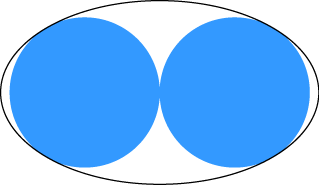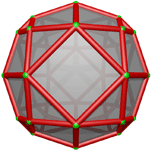
Sphere Packing and Kissing Numbers
Problems of arranging balls densely arise in many
situations, particularly in coding theory (the balls are formed by the
sets of inputs that the error-correction would map into a single
codeword).
The most important question in this area is Kepler's problem:
what is the most dense packing of spheres in space?
The answer is obvious to anyone who has seen grapefruit stacked in a
grocery store, but a proof remains elusive.
(It is known, however, that the usual grapefruit packing is
the densest packing in which the sphere centers form a
lattice.)
The colorfully named "kissing number problem" refers
to the local density of packings: how many balls can touch another ball?
This can itself be viewed as a version of Kepler's problem
for spherical rather than Euclidean geometry.
- 1st
and 2nd Ajima-Malfatti points. How to pack three circles in a
triangle so they each touch the other two and two triangle sides. This
problem has a curious history, described in Wells' Penguin Dictionary
of Curious and Interesting Geometry: Malfatti's original (1803)
question was to carve three columns out of a prism-shaped block of
marble with as little wasted stone as possible, but it wasn't until 1967
that it was shown that these three mutually tangent circles are never
the right answer.
See also
this Cabri geometry page,
the MathWorld
Malfatti circles page, and the Wikipedia
Malfatti circles page.
- Algorithmic packings
compared. Anton Sherwood looks at deterministic rules for
disk-packing on spheres.
- Apollonian Gasket,
a fractal circle packing formed by packing smaller circles into each
triangular gap formed by three larger circles.
From MathWorld.
- Basic crystallography diagrams, B. C. Taverner, Witwatersrand.
- The charged particle
model: polytopes and optimal packing of p points in n dimensional spheres.
- Circle
packing and discrete complex analysis. Research by
Ken Stephenson including pictures, a bibliography, and downloadable circle packing
software.
- Circle packings.
Gareth McCaughan describes the connection between collections
of tangent circles and conformal mapping. Includes some pretty postscript
packing pictures.
- Circles in ellipses.
James Buddenhagen asks for the smallest ellipse that contains two
disjoint unit circles.
Discussion continued in a thread on
three
circles in an ellipse.
- Dense sphere-packings in hyperbolic space.
- Densest
packings of equal spheres in a cube, Hugo Pfoertner.
With nice ray-traced images of each packing.
See also Martin
Erren's applet for visualizing the sphere packings.
- A
dream about sphere kissing numbers.
- Edge-tangent polytope illustrating Koebe's
theorem that any planar graph can be realized as the set of tangencies
between circles on a sphere. Placing vertices at points having those
circles as horizons forms a polytope with all edges tangent to the sphere.
Rendered by POVray.
- Erich's
Packing Page. Erich Friedman enjoys packing geometric shapes into
other geometric shapes.
- Figure eight knot / horoball diagram.
Research of A. Edmonds into the symmetries of knots,
relating them to something that looks
like a packing of spheres.
The MSRI Computing Group uses
another horoball
diagram as their logo.
- The fractal art of
Wolter Schraa. Includes some nice reptiles and sphere packings.
- Hermite's constants.
Are certain values associated with dense lattice packings of spheres
always rational?
Part of Mathsoft's
collection of
mathematical constants.
- Improved
dense packing of equal disks in a square, D. Boll et al., Elect. J. Combinatorics.
- The Kepler Conjecture on dense packing of spheres.
- Kissing
numbers. Eric Weisstein lists known bounds on the kissing numbers
of spheres in dimensions up to 24.
- Maximizing the
minimum distance of N points on a sphere, ray-traced by Hugo Pfoertner.
- Measurement
sample. Ed Dickey advocates teaching about sphere packings and
kissing numbers to high school students as part of a
teaching
strategy involving manipulative devices.
- Min-energy
configurations of electrons on a sphere, K. S. Brown.
- Maximum volume
arrangements of points on a sphere, Hugo Pfoertner.
- Optimal
illumination of a sphere. An interesting variation on the problem of
equally spacing points, by Hugo Pfoertner.
- Packing
circles in circles and circles on a sphere,
Jim Buddenhagen.
Mostly about optimal packing but includes also some nonoptimal spiral
and pinwheel packings.
- Packing
circles in the hyperbolic plane, Java animation by
Kevin Pilgrim illustrating the effects of changing radii in the
hyperbolic plane.
- Packing
pennies in the plane, an illustrated proof of Kepler's conjecture in
2D by Bill Casselman.
- Packing
results, D. Boll. C code for finding dense packings of circles in
circles, circles in squares, and spheres in spheres.
- Packomania!
- Pennies in
a tray, Ivars Peterson.
- Pentagon
packing on a circle and on a sphere,
T. Tamai.
- Points on
a sphere. Paul Bourke describes a simple random-start hill-climbing
heuristic for spreading points evenly on a sphere, with pretty pictures
and C source.
- Satellite
constellations. Sort of a dynamic version of a sphere packing
problem: how to arrange a bunch of satellites so each point of the
planet can always see one of them?
- Oded
Schramm's mathematical picture gallery primarily concentrating in
square tilings and circle packings, many forming fractal patterns.
- N.
J. A. Sloane's netlib directory includes many references and programs for
sphere packing and clustering in various models. See also his
list
of sphere-packing and lattice theory publications.
- Soddy's Hexlet,
six spheres in a ring tangent to three others,
and Soddy's
Bowl of Integers, a sphere packing combining infinitely many hexlets,
from Mathworld.
- Sphere distribution problems.
Page of links to other pages, collected by Anton Sherwood.
- Spheres
and lattices. Razvan Surdulescu computes sphere volumes and
describes some lattice packings of spheres.
- Spheres with
colorful chickenpox. Digana Swapar describes an algorithm for
spreading points on a sphere to minimize the electrostatic potential,
via a combination of simulated annealing and conjugate gradient optimization.
- Spontaneous
patterns in disk packings, Lubachevsky, Graham, and Stillinger,
Visual Mathematics. A procedure for packing unit disks into square
containers produces large grains of hexagonally packed disks
with sporadic rattlers along the grain boundaries.
- Waterman polyhedra,
formed from the convex hulls of centers of points near the origin in an
alternating lattice.
See also Paul
Bourke's Waterman Polyhedron page.
- What is
arbelos you ask?
From the Geometry Junkyard,
computational
and recreational geometry pointers.
Send email if you
know of an appropriate page not listed here.
David Eppstein,
Theory Group,
ICS,
UC Irvine.
Semi-automatically
filtered
from a common source file.

